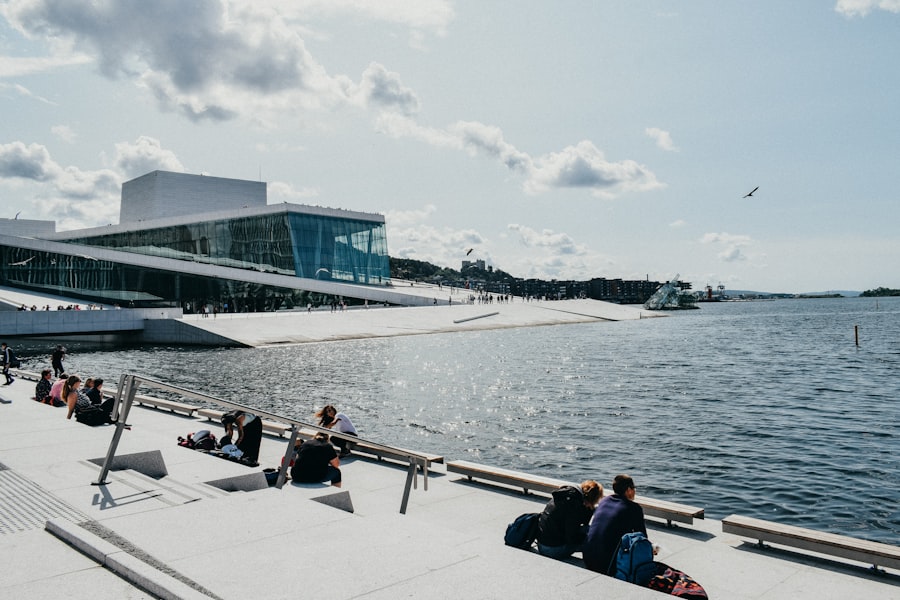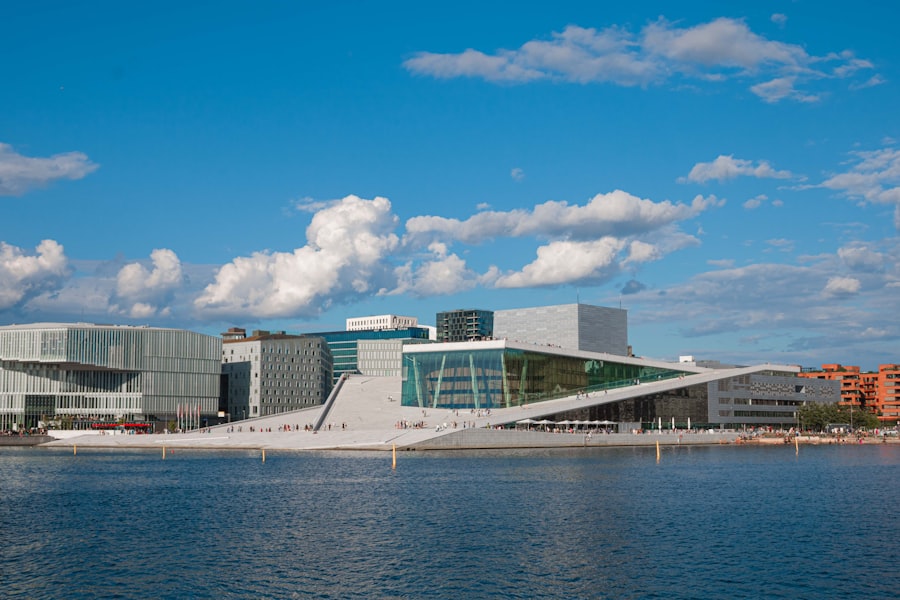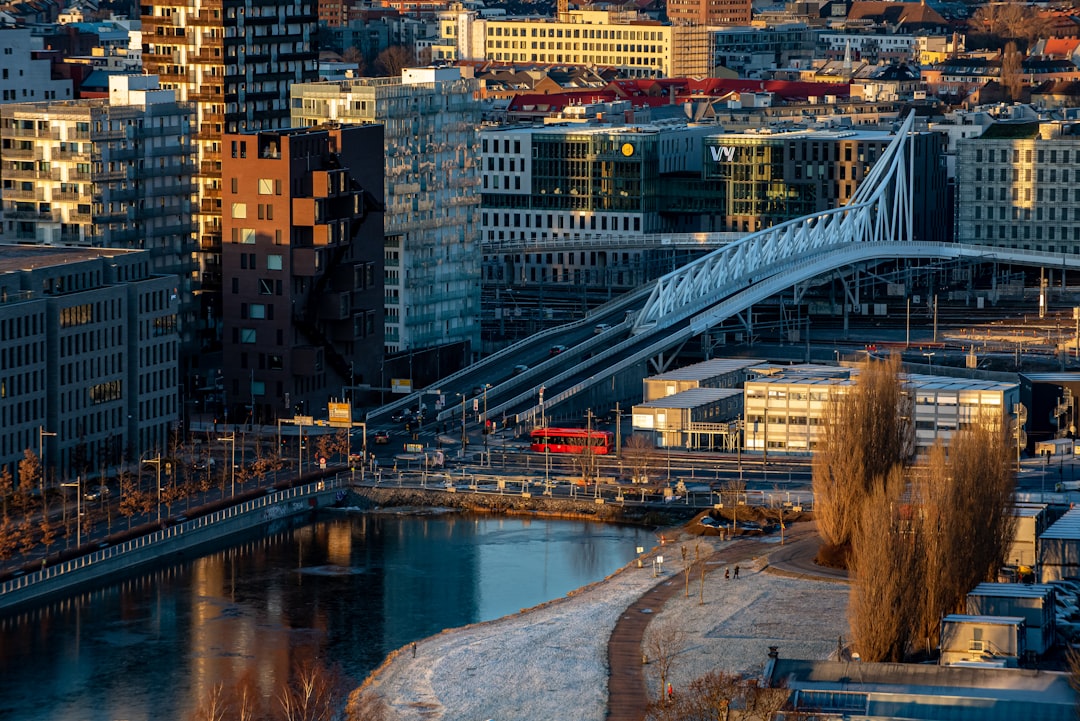Oslo, the capital of Norway, is a vibrant city known for its rich history, stunning architecture, and breathtaking natural landscapes. As the city continues to grow and evolve, so too does its public transportation system, which plays a crucial role in connecting residents and visitors alike to various parts of the city and beyond. The public transportation network in Oslo is not only efficient but also environmentally friendly, making it an attractive option for those looking to explore the city without the hassle of driving or parking.
The public transportation system in Oslo is designed to be user-friendly and accessible, catering to the needs of a diverse population. With a combination of buses, trams, metro lines, and ferries, the network provides comprehensive coverage across the city and its surrounding areas. This article will delve into the various aspects of public transportation in Oslo, including the types of transport available, ticketing systems, accessibility features, and tips for navigating the system effectively. Take the first step. Book a consultation with the Norway Relocation Group for your move to Norway.
Summary
- Oslo’s public transportation system includes buses, trams, metro, ferries, and trains, providing extensive coverage across the city.
- Ticketing options include single tickets, day passes, and travel cards, with fares based on zones and age groups.
- Navigating the public transportation system is made easy with the use of route planners, maps, and real-time information available at stations and online.
- Oslo’s public transportation system is designed to be accessible for passengers with disabilities, offering facilities such as low-floor vehicles and priority seating.
- To make the most of public transportation in Oslo, consider purchasing a travel card for convenience and cost savings, and familiarise yourself with popular destinations accessible by the system.
Types of Public Transportation in Oslo
Oslo boasts a multifaceted public transportation system that includes several modes of transport, each serving a unique purpose. The most prominent forms of public transport are buses, trams, and the metro system, collectively known as Ruter. Buses operate throughout the city and its suburbs, providing essential connections to residential areas and key destinations.
They are particularly useful for reaching locations that may not be directly accessible by tram or metro. Trams are another vital component of Oslo’s public transport network. The tram system is not only efficient but also offers a scenic way to traverse the city.
With several lines running through central Oslo, trams provide easy access to popular areas such as Grünerløkka and Majorstuen. The metro system, known as T-banen, is perhaps the backbone of public transport in Oslo. It features multiple lines that extend from the city centre to the outskirts, making it an ideal choice for commuters and tourists alike.
Ticketing and Fares for Public Transportation in Oslo

Navigating the ticketing system for public transportation in Oslo is straightforward, thanks to Ruter’s integrated fare structure. Passengers can purchase tickets for individual journeys or opt for various travel passes that offer unlimited travel within specified timeframes. Tickets can be bought at ticket machines located at metro stations, on buses, or via the Ruter app, which allows for convenient mobile ticketing.
Fares are determined based on zones within the city. Oslo is divided into several fare zones, with prices varying depending on how many zones a passenger travels through. For those who plan to use public transport frequently during their stay in Oslo, a 24-hour pass or a multi-day pass can be a cost-effective option.
Additionally, discounts are available for students and seniors, making public transport accessible to a wider audience.
How to Navigate the Public Transportation System in Oslo
Navigating Oslo’s public transportation system can be an enjoyable experience with a little preparation. The Ruter app is an invaluable tool for both locals and visitors, providing real-time information on schedules, routes, and ticket purchasing options. The app also features a journey planner that helps users find the best routes based on their starting point and destination.
In addition to the app, clear signage at stations and stops makes it easy to understand where to catch your transport. Each mode of transport has its own designated stops, and timetables are displayed prominently. For those who prefer a more traditional approach, printed maps and schedules are available at various locations throughout the city.
Familiarising oneself with the layout of the metro lines and tram routes can significantly enhance the travel experience.
Accessibility and Facilities for Passengers with Disabilities
Oslo’s public transportation system is committed to ensuring accessibility for all passengers, including those with disabilities. Many metro stations are equipped with elevators and ramps, making it easier for individuals with mobility challenges to access trains. Additionally, buses are designed with low floors and designated spaces for wheelchairs, ensuring that all passengers can board safely.
Trams also feature accessibility options, with many stops equipped with tactile paving to assist visually impaired passengers. Furthermore, announcements on public transport vehicles are made both visually and audibly, providing essential information about upcoming stops. The city’s commitment to inclusivity extends beyond just physical access; staff members are trained to assist passengers with disabilities when needed.
Tips for Using Public Transportation in Oslo

To make the most of your experience using public transportation in Oslo, there are several tips worth considering. Firstly, always check the schedules ahead of time to avoid long waits at stops or stations. The Ruter app provides real-time updates on arrival times, which can be particularly helpful during peak hours when services may be busier than usual.
Another useful tip is to keep your ticket handy until you have completed your journey. While ticket inspections are not overly frequent, they do occur, and having your ticket readily available can save you from potential fines. Additionally, consider travelling during off-peak hours if possible; this not only makes for a more comfortable journey but also allows you to enjoy a quieter atmosphere while exploring the city.
Popular Destinations and Landmarks Accessible by Public Transportation
Oslo is home to numerous attractions that are easily accessible via public transportation. The iconic Opera House is just a short walk from the nearest metro station and offers stunning views of the fjord. Similarly, the Munch Museum and the National Gallery can be reached conveniently by tram or bus.
For those interested in history and culture, a visit to the Viking Ship Museum is highly recommended. Located on Bygdøy Peninsula, it can be accessed by taking a ferry from the city centre during the summer months or by bus year-round. Other notable destinations include the Royal Palace, Aker Brygge waterfront area, and Vigeland Park—all easily reachable through Oslo’s efficient public transport network.
Safety and Security Measures on Public Transportation in Oslo
Safety is a top priority within Oslo’s public transportation system. The city has implemented various measures to ensure that passengers feel secure while travelling. Surveillance cameras are installed at many stations and on vehicles to deter criminal activity and enhance passenger safety.
Moreover, public transport staff are trained to handle emergencies effectively and provide assistance when needed. Passengers are encouraged to report any suspicious behaviour or incidents to staff members or through designated hotlines. Overall, Oslo’s public transportation system maintains a reputation for being safe and reliable.
Environmental Initiatives and Sustainability in Oslo’s Public Transportation
Oslo is renowned for its commitment to sustainability and environmental initiatives, particularly within its public transportation sector. The city has made significant investments in electric buses and trams to reduce carbon emissions and improve air quality. This shift towards greener transport options aligns with Oslo’s broader goal of becoming a carbon-neutral city by 2030.
Additionally, efforts have been made to promote cycling as an alternative mode of transport alongside public transit. Bike-sharing schemes have been introduced in conjunction with public transport services, allowing passengers to combine cycling with their journeys seamlessly. These initiatives not only contribute to reducing traffic congestion but also encourage healthier lifestyles among residents.
Future Developments and Expansion of Public Transportation in Oslo
As Oslo continues to grow as a metropolitan hub, plans for future developments in its public transportation system are already underway. The city aims to expand its metro network further into surrounding areas to accommodate increasing demand from commuters. New lines are being proposed that will connect previously underserved regions with central Oslo.
Moreover, there is an ongoing focus on enhancing existing infrastructure to improve efficiency and reliability. Upgrades to stations and vehicles are planned as part of a broader strategy to modernise the entire network. These developments reflect Oslo’s commitment to providing an effective public transport system that meets the needs of its residents while promoting sustainable urban growth.
Comparing Public Transportation with Other Modes of Transport in Oslo
When considering how best to navigate Oslo, public transportation stands out as one of the most efficient options available. While taxis and ride-sharing services offer convenience for short distances or late-night travel, they can be significantly more expensive than using public transport. Additionally, driving in Oslo can be challenging due to traffic congestion and limited parking availability.
Cycling is another popular mode of transport in Oslo; however, it may not be suitable for everyone or every situation—especially during inclement weather or for longer distances. In contrast, public transportation provides a reliable alternative that connects various parts of the city seamlessly while allowing passengers to relax during their journey. In conclusion, Oslo’s public transportation system offers an extensive range of options that cater to both residents and visitors alike.
With its commitment to accessibility, safety, sustainability, and future expansion plans, it remains an integral part of life in this beautiful city. For those looking to immerse themselves further into Norwegian culture while navigating this efficient network, consider enrolling in Norwegian courses at the NLS Norwegian Language School in Oslo. These courses provide an excellent opportunity not only to learn the language but also to gain insights into local customs and enhance your overall experience while exploring this remarkable city through its public transport system.
Learn more about the Norwegian classes at the NLS Norwegian Language School in Oslo

